Protective Properties of Calcareous Deposit Layer for Cathodically Polarized AH36 Steel in Natural Seawater
Abstract
1. Introduction
2. Materials and Methods
2.1. Materials
2.2. Polarizing Method
2.3. Sampling Methods and Analysis Techniques
3. Results and Discussion
3.1. Characteristics of the Calcareous Deposit
3.2. Electrochemical Performance
3.2.1. Polarization Curves
3.2.2. Electrochemical Impedance
3.3. The Macro-biofouling
4. Conclusions
Author Contributions
Funding
Institutional Review Board Statement
Informed Consent Statement
Data Availability Statement
Acknowledgments
Conflicts of Interest
References
- Vedaprakash, L.; Dineshram, R.; Ratnam, K.; Lakshmi, K.; Jayaraj, K.; Mahesh Babu, S.; Venkatesan, R.; Shanmugam, A. Experimental studies on the effect of different metallic substrates on marine biofouling. Colloids Surf. B Biointerfaces 2013, 106, 1–10. [Google Scholar] [CrossRef]
- Crupi, V.; Guglielmino, E.; Maestro, M.; Marino, A. Fatigue analysis of butt welded AH36 steel joints: Thermographic method and design S-N curve. Mar. Struct. 2009, 22, 373–386. [Google Scholar] [CrossRef]
- Lu, Y.; Ding, Y.; Wang, M.; Yang, L.; Wang, Y. An environmentally Friendly Laser Cleaning Method to Remove Oceanic Micro-Biofoulings from AH36 Steel Substrate and Corrosion Protection. J. Clean. Prod. 2021, 314, 127961–127972. [Google Scholar] [CrossRef]
- Vulkelic, G.; Vizentin, G.; Ivosevic, S.; Bozic, Z. Analysis of prolonged marine exposure on properties of AH36 steel. Eng. Fail. Anal. 2022, 135, 106132. [Google Scholar] [CrossRef]
- Wang, L.; Li, H.; Huang, Y.; Wang, K.; Zhou, M. Effect of Preheating on Martensitic Transformation in the Laser Beam Welded AH36 Steel Joint: A Numerical Study. Metals 2022, 12, 127. [Google Scholar] [CrossRef]
- Pratikno, H.; Titah, H.S.; Handayanu Mahardhika, G.R. Impressed Current Anti Fouling (ICAF) to Reduce Population of Chlorella Vulgaris Cause Bio Corrosion on AH36 Steel in Marine Environment. E3S Web Conf. 2019, 125, 06001. [Google Scholar] [CrossRef]
- Michopoulos, J.G.; Iliopoulos, A.P.; Steuben, J.C.; DeGiorgi, V. Towards an Analytical, Computational and Experimental Framework for Predicting Aging of Cathodic Surfaces. In Proceedings of the ASME 2017 International Design Engineering Technical Conferences and Computers and Information in Engineering Conference, Cleveland, OH, USA, 6–9 August 2017; Volume 1. [Google Scholar] [CrossRef]
- Touzain, S.; Le Thu, Q.; Bonnet, G. Evaluation of thick organic coatings degradation in seawater using cathodic protection and thermally accelerated test. Prog. Org. Coat. 2005, 52, 311–319. [Google Scholar] [CrossRef]
- Li, X.W.; Du, S.M.; Ma, C.H.; Shi, T.; Qi, W.; Yang, H.J. Nano-SiO2 based anti-corrosion superhydrophobic coating on Al alloy with me-chanical stability, anti-pollution and self-cleaning properties. Ceram. Int. 2024, 50, 9469–9478. [Google Scholar] [CrossRef]
- Pedeferri, P. Evans Diagrams. In Corrosion Science and Engineering. Engineering Materials; Springer, Springer Nature Switzerland: Cham, Switzerland, 2018; 737p. [Google Scholar]
- Googan, C. The cathodic protection potential criteria:Evaluation of the evidence. Mater. Corros. 2020, 72, 446–464. [Google Scholar] [CrossRef]
- Carré, C.; Zanibellato, A.; Jeannin, M.; Sabot, R.; Gunkel-Grillon, P.; Serres, A. Electrochemical calcareous deposition in seawater. A review. Environ. Chem. Lett. 2020, 18, 1193–1208. [Google Scholar] [CrossRef]
- Chen, T.; Neville, A.; Yuan, M. Calcium carbonate scale formation –assessing the initial stages of precipitation and deposition. J. Pet. Sci. Eng. 2005, 46, 185–194. [Google Scholar] [CrossRef]
- Tlili, M.M.; Benamor, M.; Gabrielli, C.; Perrot, H.; Tribollet, B. Influence of the interfacial pH on electrochemical CaCO3 precipitation. J. Electrochem Soc. 2003, 150, C765. [Google Scholar] [CrossRef]
- Loto, C. Calcareous Deposits and Effects on Steels Surfaces in Seawater—A Review and Experimental Study. Orient. J. Chem. 2018, 34, 2332–2341. [Google Scholar] [CrossRef]
- Barchiche, C.; Deslouis, C.; Festy, D.; Gil, O.; Refait, P.; Touzain, S.; Tribollet, B. Characterization of calcareous deposits in artificial seawater by impedance techniques: III. Deposit of CaCO3 in the presence of Mg(II). Electrochim. Acta 2003, 48, 1645–1654. [Google Scholar] [CrossRef]
- Barchiche, C.; Deslouis, C.; Gil, O.; Refait, P.; Tribollet, B. Characterisation of calcareous deposits by electrochemical methods: Role of sulphates, calcium concentration and temperature. Electrochim. Acta 2004, 49, 2833–2839. [Google Scholar] [CrossRef]
- Stumn, W.; Morgan, J. Aquatic Chemistry. Chemical Equilibria and Rates in Natural Water; J. Wiley and Sons. Inc.: Hoboken, NJ, USA, 1996. [Google Scholar]
- Carré, C.; Gunkel-Grillon, P.; Serres, A.; Jeannin, M.; Sabot, R.; Quiniou, T. Laboratory and in situ investigations for trapping Pb and Ni with an unusual electrochemical device, the calcareous deposit in seawater. Sci. Rep. 2019, 9, 3–10. [Google Scholar] [CrossRef]
- Eashwar, M.; Subramanian, G.; Palanichamy, S.; Rajagopal, G.; Madhu, S.; Kamaraj, P. Cathodic behaviour of stainless steel in coastal Indian seawater: Calcareous deposits overwhelm biofilms. Biofouling 2009, 25, 191–201. [Google Scholar] [CrossRef]
- Park, J.M.; Lee, M.H.; Lee, S.H. Characteristics and Crystal Structure of Calcareous Deposit Films Formed by Electrodeposition Process in Artificial and Natural Seawater. Coatings 2021, 11, 1–12. [Google Scholar] [CrossRef]
- Nguyen, D.D.; Gascoin, S.; Zanibellato, A.; Da Silva, C.; Lemoine, M.; Riffault, B.; Sabot, R.; Jeannin, M.; Chateigner, D.; Gil, O. Role of brucite dissolution in calcium carbonate precipitation from artificial and natural seawaters. Cryst. Growth Des. 2017, 17, 1502–1513. [Google Scholar] [CrossRef]
- Bano, M.; Rodger, M.; Quigley, D. New Insight into the Stability of CaCO3 Surfaces and Nanoparticles via Molecular Simulation. Langmuir 2014, 30, 7513–7521. [Google Scholar] [CrossRef]
- Vuong, P.; McKinley, A.; Kaur, P. Understanding biofouling and contaminant accretion on submerged marine structures. npj Mater. Degrad. 2023, 50, 1–11. [Google Scholar] [CrossRef]
- Nataly, C.; Shiladitya, P. The Effect of Temperature and Local pH on Calcareous Deposit Formation in Damaged Thermal Spray Aluminum (TSA) Coatings and Its Implication on Corrosion Mitigation of Offshore Steel Structures. Coatings 2017, 7, 52. [Google Scholar] [CrossRef]
- Li, C.; Du, M.; Qiu, J.; Zhang, J.; Gao, C. Influence of Temperature on the Protectiveness and Morphological Characteristics of Calcareous Deposits Polarized by Galvanostatic Mode. Acta Metall. Sin. 2014, 27, 131–139. [Google Scholar] [CrossRef]
- Chi, N.V.; Quan, L.H.; Linh, C.N.; Quang, N.Q.; Anh, N.D.; Kien, D.V.; Hoa, N.V. Electrodeposition of Cu-Reinforced Polyaniline Coating for Protection of AH36 Steel in Natural Seawater. Coatings 2022, 12, 1680. [Google Scholar] [CrossRef]
- Nguyen, V.C.; Cao, N.L.; Dong, V.K.; Le, H.Q.; Mai, V.M.; Nong, Q.Q.; Zyablov, A.N. Corrosion behavior of AH-36 steel in seawater. Butlerov Commun. 2020, 63, 113–118. [Google Scholar] [CrossRef]
- Nguyen, V.C.; Cao, N.L.; Dong, V.K.; Le, H.Q.; Nong, Q.Q.; Zyablov, A.N. Study on structural steel AH-36 corrosion in the marine environment of Vietnam. ChemChemTech 2021, 64, 139–144. [Google Scholar] [CrossRef]
- Li, C.J.; Du, M. The growth mechanism of calcareous deposits under various hydrostatic pressures during the cathodic protection of carbon steel in seawater. RSC Adv. 2017, 7, 28819–28825. [Google Scholar] [CrossRef]
- Belmonte, M.R.; Quiroz, T.P.; Salas, B.V.; Madrid, M.M.; Acosta, A.T.; Calderon, J.P.; Wiener, M.S. Characterization of steel surface under cathodic protection in seawater. Anti-Corros. Methods Mater. 2013, 60, 160–167. [Google Scholar] [CrossRef]
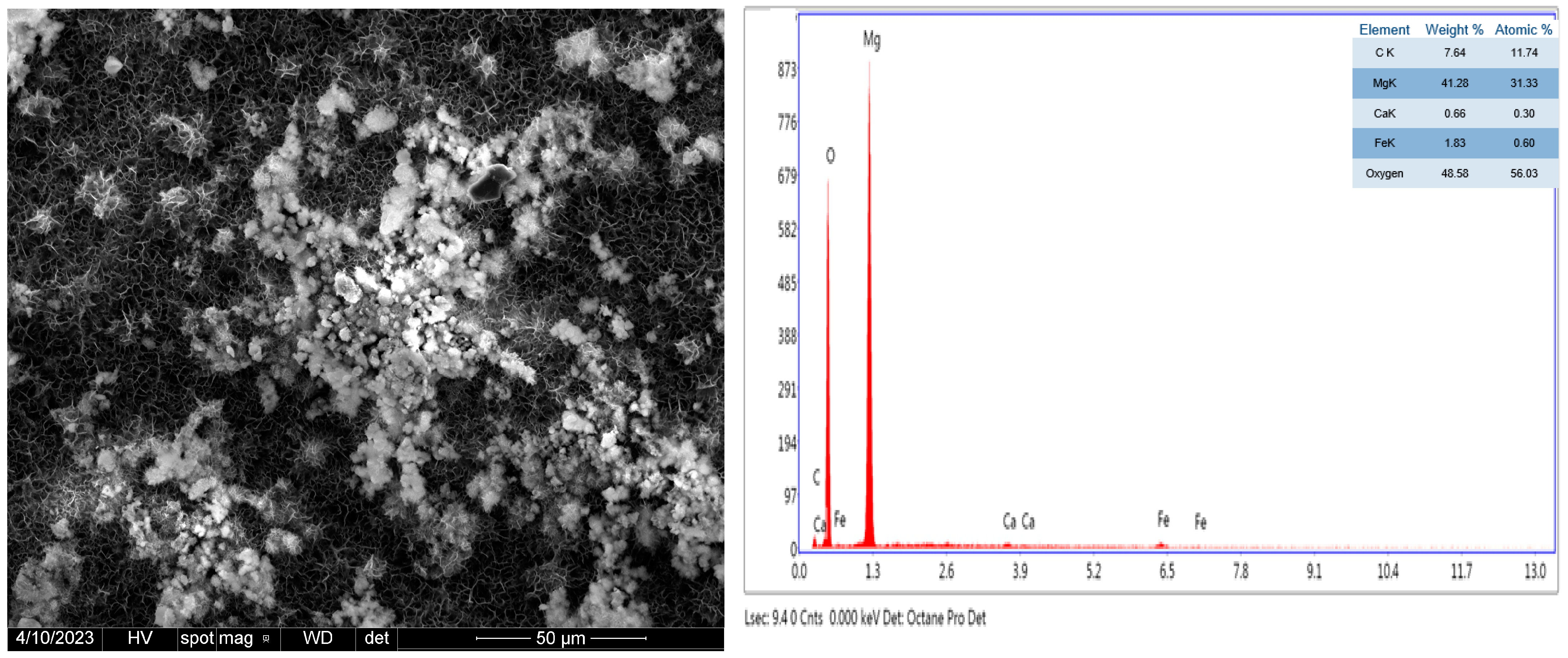

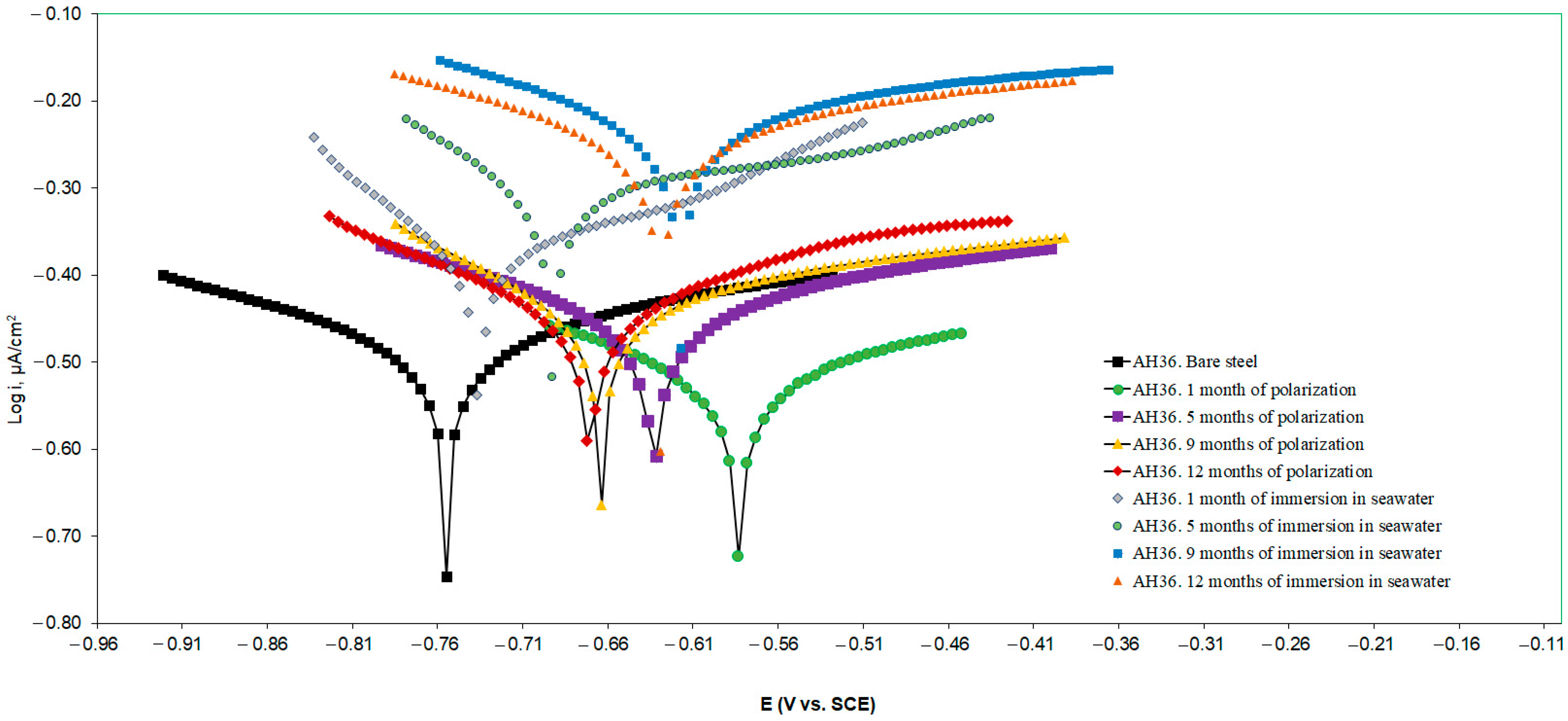
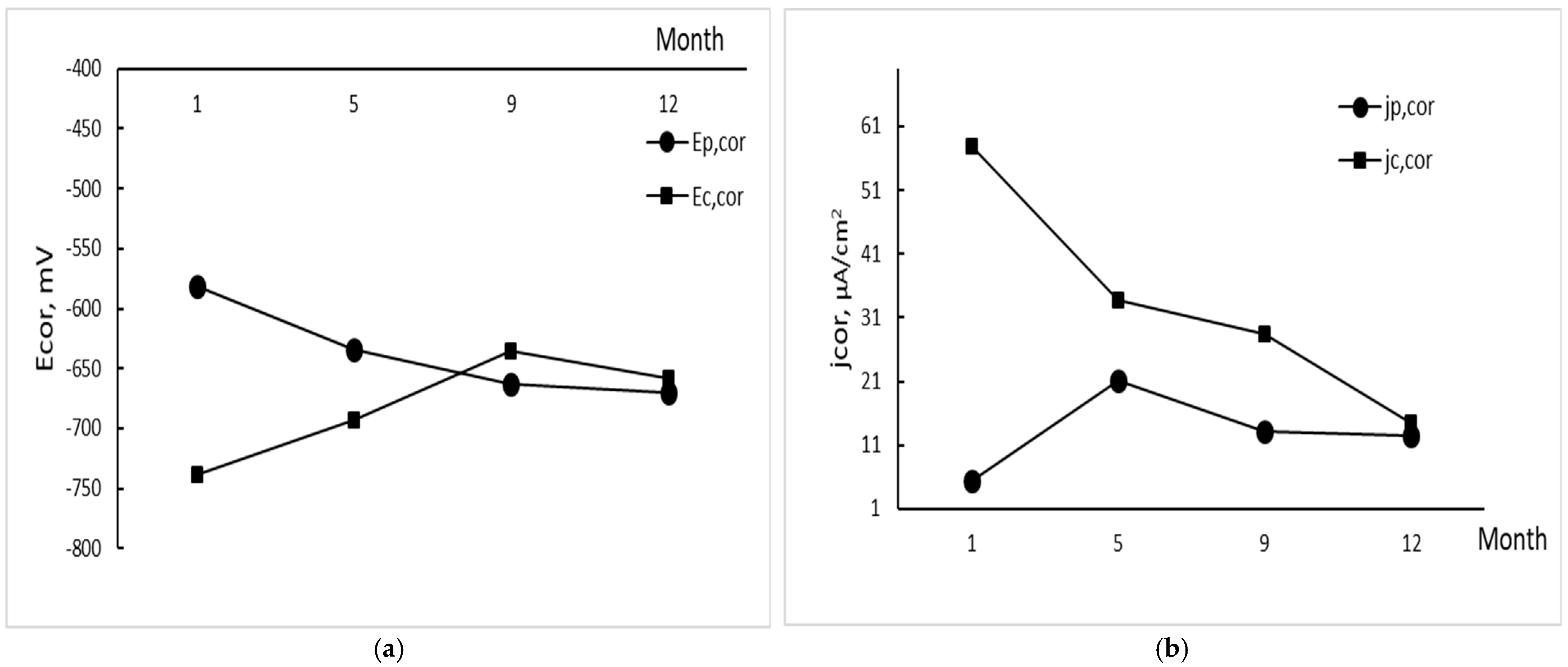
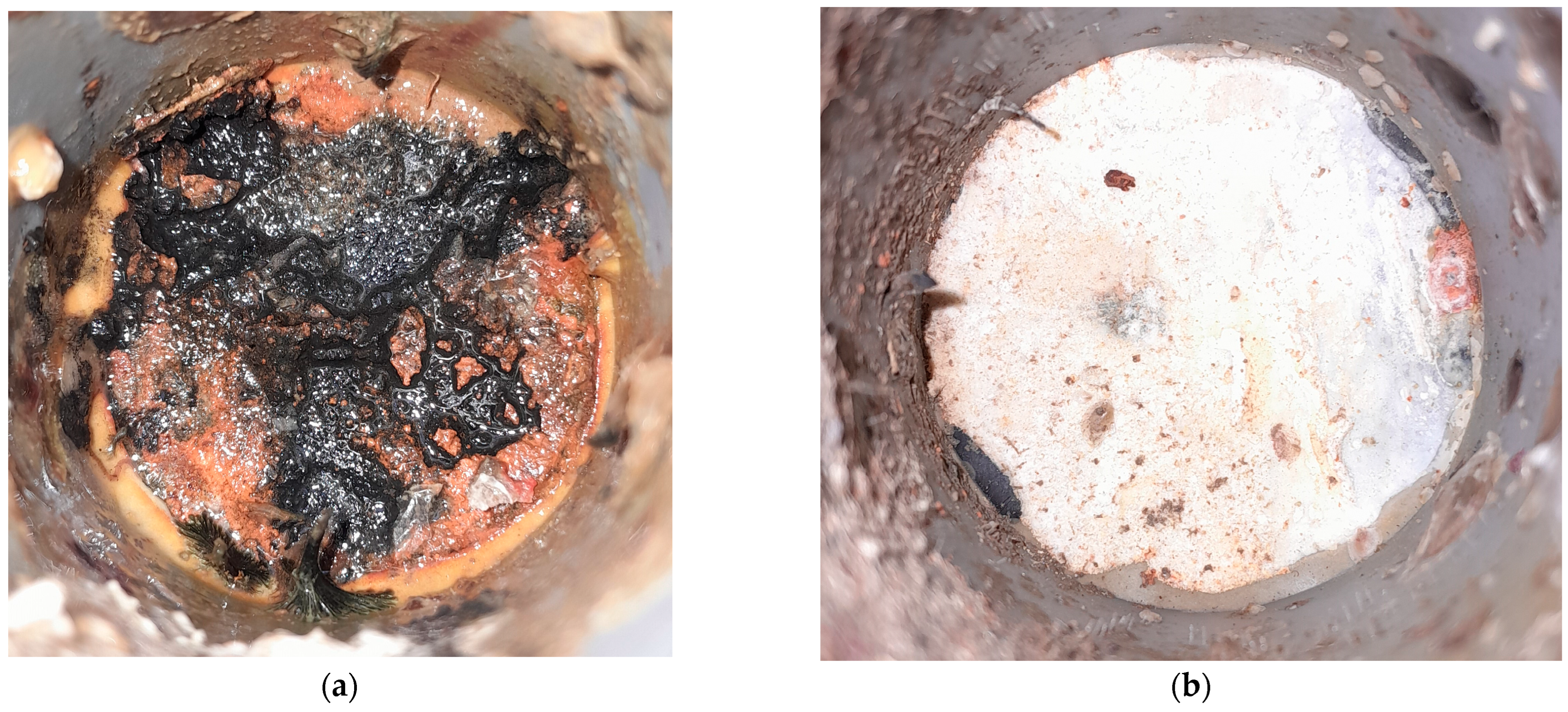
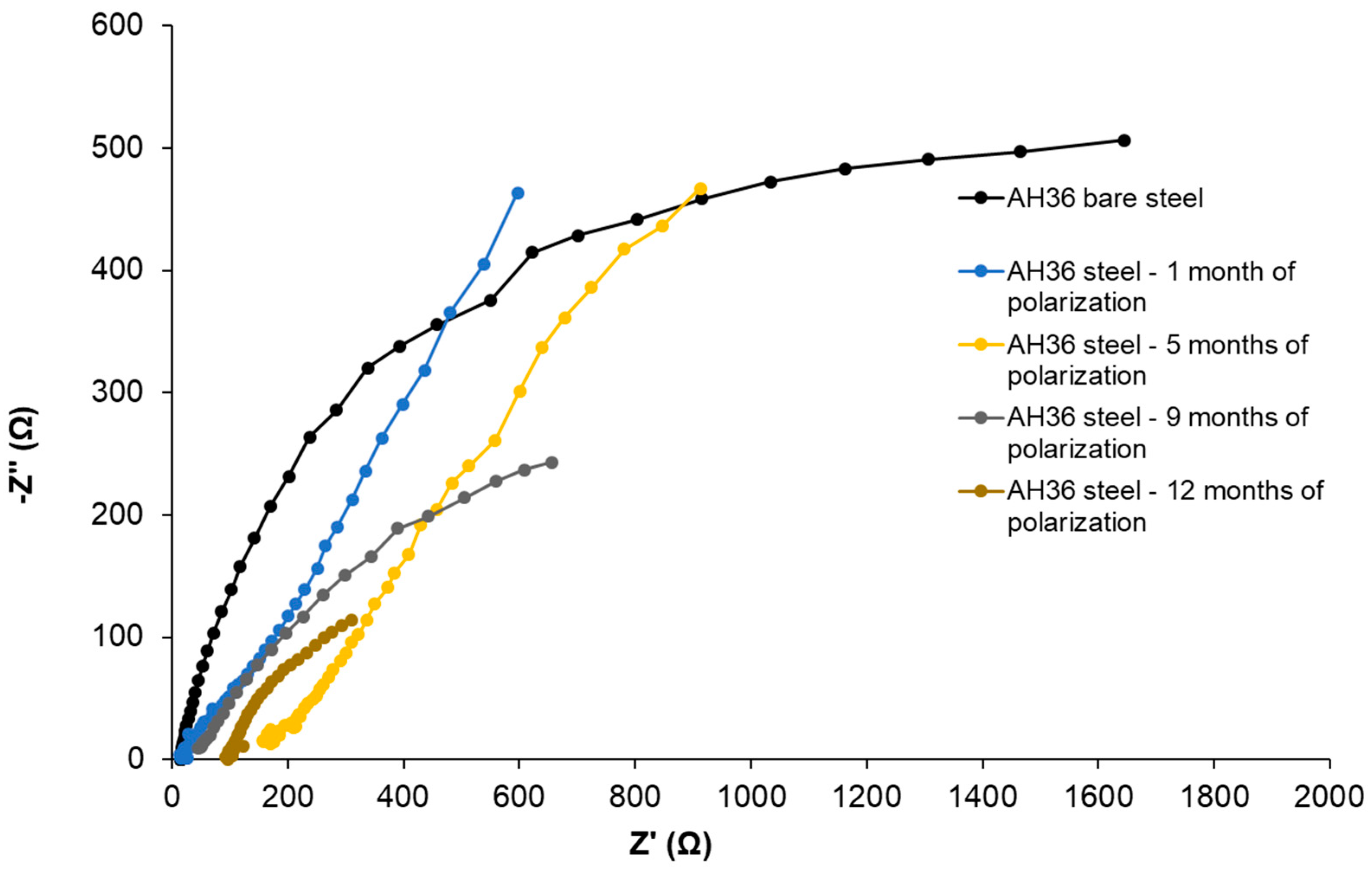


| Parameters from Extrapolation | AH36 Steel Cathode Samples/Unprotected AH36 Steel Samples | AH36 Bare Steel | |||
|---|---|---|---|---|---|
| for 1 Month | for 5 Months | for 9 Months | for 12 Months | ||
| Corrosion potential (mV) | −581/−738 | −634/−693 | −663/−635 | −670/−658 | −736 |
| Corrosion current density (µA/cm2) | 5.4/57.9 | 21.1/33.8 | 13.1/28.5 | 12.5/14.5 | 58.5 |
| Polarization resistor (Ω) | 1991/65.7 | 496/188 | 372/65.6 | 373/76 | 65.6 |
| Anode slope βa (mV/dec) | 347/107 | 355/148 | 149/109 | 180/359 | 109 |
| Cathode slope βc (mV/dec) | 638/306 | 565/1311 | 317/303 | 213/657 | 303 |
| Parameters | AH36 Bare Steel | AH36-1 | AH36-5 | AH36-9 | AH36-12 |
|---|---|---|---|---|---|
| Re (Ω.cm2) | 1.3 | 1.93 | 6.08 | 15.86 | 32.2 |
| Rct (Ω.cm2) | 65.6 | 50.23 | 45.94 | 70.39 | 70.6 |
| Rf (Ω.cm2) | - | 9.53 | 15.31 | 13.33 | 13.88 |
| CPE1 * (µF.cm−2) | - | 53,463 | 29,137 | 45,294 | 14,250 |
| CPE2 * (µF.cm−2) | - | 1180 | 1652 | 481 | 726 |
| Cdl (µF.cm−2) | 1159 | - | - | - | - |
Disclaimer/Publisher’s Note: The statements, opinions and data contained in all publications are solely those of the individual author(s) and contributor(s) and not of MDPI and/or the editor(s). MDPI and/or the editor(s) disclaim responsibility for any injury to people or property resulting from any ideas, methods, instructions or products referred to in the content. |
© 2024 by the authors. Licensee MDPI, Basel, Switzerland. This article is an open access article distributed under the terms and conditions of the Creative Commons Attribution (CC BY) license (https://creativecommons.org/licenses/by/4.0/).
Share and Cite
Nong, Q.Q.; Dong, V.K.; Nguyen, V.T.; Nguyen, V.C.; Le, H.Q.; Cao, N.L. Protective Properties of Calcareous Deposit Layer for Cathodically Polarized AH36 Steel in Natural Seawater. Coatings 2024, 14, 644. https://doi.org/10.3390/coatings14050644
Nong QQ, Dong VK, Nguyen VT, Nguyen VC, Le HQ, Cao NL. Protective Properties of Calcareous Deposit Layer for Cathodically Polarized AH36 Steel in Natural Seawater. Coatings. 2024; 14(5):644. https://doi.org/10.3390/coatings14050644
Chicago/Turabian StyleNong, Quoc Quang, Van Kien Dong, Van Trieu Nguyen, Van Chi Nguyen, Hong Quan Le, and Nhat Linh Cao. 2024. "Protective Properties of Calcareous Deposit Layer for Cathodically Polarized AH36 Steel in Natural Seawater" Coatings 14, no. 5: 644. https://doi.org/10.3390/coatings14050644
APA StyleNong, Q. Q., Dong, V. K., Nguyen, V. T., Nguyen, V. C., Le, H. Q., & Cao, N. L. (2024). Protective Properties of Calcareous Deposit Layer for Cathodically Polarized AH36 Steel in Natural Seawater. Coatings, 14(5), 644. https://doi.org/10.3390/coatings14050644






